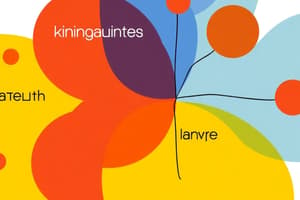Podcast
Questions and Answers
What is the main difference between denotation and connotation?
What is the main difference between denotation and connotation?
- Denotation is used in informal language, while connotation is used in formal language.
- Denotation is more subjective, while connotation is more objective.
- Denotation is about the literal meaning, while connotation is about the emotional or cultural implication. (correct)
- Denotation is about the emotional association, while connotation is about the literal meaning.
What does the word 'home' connote?
What does the word 'home' connote?
- A sense of boredom and loneliness.
- A sense of comfort, safety, and warmth. (correct)
- A sense of insecurity and danger.
- A sense of freedom and adventure.
Why is it important to understand connotations in language?
Why is it important to understand connotations in language?
- To impress others with your knowledge of words.
- To avoid using complex vocabulary.
- To communicate more effectively and avoid unintended implications. (correct)
- To focus on the literal meaning of words.
What is the denotation of the word 'dog'?
What is the denotation of the word 'dog'?
What should you consider when choosing words to convey your intended meaning?
What should you consider when choosing words to convey your intended meaning?
What is the result of using words with positive connotations?
What is the result of using words with positive connotations?
ما هو نوع الفعل الذي يستخدم لوصف الفعل الذي حدث قبل فعل آخر في الماضي؟
ما هو نوع الفعل الذي يستخدم لوصف الفعل الذي حدث قبل فعل آخر في الماضي؟
ما هو نوع الفعل الذي يستخدم لوصف الفعل الذي بدأ في الماضي ولا يزال مستمراً حتى اللحظة الحالية؟
ما هو نوع الفعل الذي يستخدم لوصف الفعل الذي بدأ في الماضي ولا يزال مستمراً حتى اللحظة الحالية؟
ما هو شكل الفعل الماضي البسيط؟
ما هو شكل الفعل الماضي البسيط؟
ما هو الغرض من استخدام الفعل المضارع البسيط؟
ما هو الغرض من استخدام الفعل المضارع البسيط؟
ما هو Beispiel على الفعل الماضي التام؟
ما هو Beispiel على الفعل الماضي التام؟
ما هو Beispiel على الفعل المضارع التام؟
ما هو Beispiel على الفعل المضارع التام؟
What is the main function of the Present Simple tense?
What is the main function of the Present Simple tense?
How is the Past Perfect tense formed?
How is the Past Perfect tense formed?
What is the main function of the Present Perfect tense?
What is the main function of the Present Perfect tense?
How is the Past Simple tense formed for regular verbs?
How is the Past Simple tense formed for regular verbs?
What is the main function of the Past Perfect tense?
What is the main function of the Past Perfect tense?
What is the main difference between the Present Simple and the Present Perfect tenses?
What is the main difference between the Present Simple and the Present Perfect tenses?
Flashcards are hidden until you start studying
Study Notes
Connotation and Denotation
Definition
- Denotation: The literal or dictionary meaning of a word, focusing on its objective definition.
- Connotation: The emotional or cultural association that a word evokes, beyond its literal meaning.
Key Differences
- Denotation is about the word's literal meaning, while connotation is about the emotional or cultural implication.
- Denotation is more objective, while connotation is more subjective.
Examples
- Denotation:
- The word "home" denotes a physical building or residence.
- The word "dog" denotes a specific animal species.
- Connotation:
- The word "home" connotes a sense of comfort, safety, and warmth.
- The word "dog" connotes loyalty, friendship, and affection.
Importance in Language
- Connotations can influence how people perceive and respond to words and messages.
- Understanding connotations can help communicate more effectively and avoid unintended implications.
Tips for Effective Communication
- Be aware of the connotations of words to convey intended meaning.
- Consider the audience and cultural context to avoid misinterpretation.
- Use words with positive connotations to create a more positive tone.
Connotation and Denotation
Definition
- Denotation refers to the literal or dictionary meaning of a word, focusing on its objective definition.
- Connotation refers to the emotional or cultural association that a word evokes, beyond its literal meaning.
Key Differences
- Denotation is objective, focusing on the word's literal meaning, whereas connotation is subjective, involving emotional or cultural implications.
- Denotation is more about the word's definition, while connotation is about the feelings or attitudes associated with it.
Examples
Denotation Examples
- The word "home" literally means a physical building or residence.
- The word "dog" literally refers to a specific animal species.
Connotation Examples
- The word "home" evokes feelings of comfort, safety, and warmth.
- The word "dog" is often associated with loyalty, friendship, and affection.
Importance in Language
- Connotations can significantly influence how people perceive and respond to words and messages.
- Understanding connotations helps communicate more effectively and avoid unintended implications.
Tips for Effective Communication
- Be aware of the connotations of words to convey intended meaning.
- Consider the audience and cultural context to avoid misinterpretation.
- Using words with positive connotations can create a more positive tone.
Verb Tenses
Past Simple
- Used to describe completed actions in the past
- Formed using the verb's past tense form (e.g. "went", "did", "made")
- Often used with time expressions like "yesterday", "last week", "in 2010"
- Indicates an action that started and finished in the past
Past Perfect
- Used to describe an action that occurred before another action in the past
- Formed using "had" + past participle (e.g. "had gone", "had eaten", "had studied")
- Often used to show cause and effect or to clarify the order of events
- Indicates that one action in the past was completed before another action started
Present Simple
- Used to describe habitual or regular actions
- Formed using the base form of the verb (e.g. "go", "make", "study")
- Often used to describe facts, habits, or general truths
- Indicates an action that is true in general or happens regularly
Present Perfect
- Used to describe an action that started in the past and continues up to the present moment
- Formed using "has" or "have" + past participle (e.g. "has gone", "have eaten", "have studied")
- Often used to describe experiences, accomplishments, or changes
- Indicates that an action started in the past and has a connection to the present
Verb Tenses
Present Simple
- Describes habitual or routine actions, e.g., I go to school every day
- Used for general truths or facts, e.g., Water boils at 100°C
- Used for scheduled events
- Formed using base form of the verb for I, you, we, and they
- Formed using base form + -s or -es for he, she, and it
Present Perfect
- Describes actions that started in the past and continue up to the present
- Used for experiences or accomplishments, e.g., I have studied English for three years
- Used for actions that have a connection to the present
- Formed using has/have + past participle of the verb
Past Simple
- Describes completed actions in the past
- Used for specific times or dates in the past, e.g., I went to the movies last night
- Formed using -ed added to the base form of regular verbs
- Irregular verbs have unique past tense forms
Past Perfect
- Describes actions that occurred before another action in the past
- Used for completed actions in the past that have a connection to another action in the past
- Formed using had + past participle of the verb
- Examples: I had eaten dinner before I went to the movies
Studying That Suits You
Use AI to generate personalized quizzes and flashcards to suit your learning preferences.




